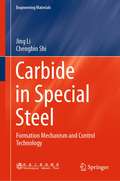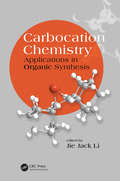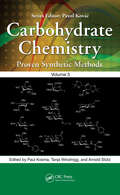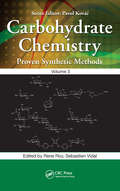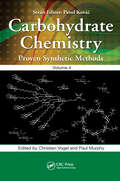- Table View
- List View
Carabid Beetles in Their Environments: A Study on Habitat Selection by Adaptations in Physiology and Behaviour (Zoophysiology #10)
by H.U. ThieleWith the increasing numbers of research workers and groups of investigators devoting themselves to the ecology of carabids I felt that the time had come to take stock of the existing knowledge in this field and to endeavour to weld my personal results and those of other workers into a comprehensive picture. It was with these aims in mind that the following study was conceived. A further goal was to attempt to show to what extent research on carabids can contribute to the larger fields of research encompassing ecology, ethology and evolution. In my opinion the investigations on carabids permit us to draw conclusions of general applicability and, as such, comparable with those made in recent years upon other groups of animals. I am well aware of the risk involved nowadays in attempting, on one's own, to integrate results from a wide variety of scientific disciplines into a meaningful whole, and for this reason I am always grateful for corrections and for additional information. It is impossible for me to mention by name all of the col leagues who have given me their support in the preparation of the book. Reprints of their publications have been placed at my disposal by almost all of the authors cited, as well as by others whose names and works have been omitted merely in order to prevent the book from taking on encyclopedic pro portions. I am nevertheless indebted to them all for their cooperation.
Carbid und Acetylen: Als Ausgangsmaterial für Produkte der Chemischen Industrie
by J. H. Vogel Armin Schulze-AltenburgDieser Buchtitel ist Teil des Digitalisierungsprojekts Springer Book Archives mit Publikationen, die seit den Anfängen des Verlags von 1842 erschienen sind. Der Verlag stellt mit diesem Archiv Quellen für die historische wie auch die disziplingeschichtliche Forschung zur Verfügung, die jeweils im historischen Kontext betrachtet werden müssen. Dieser Titel erschien in der Zeit vor 1945 und wird daher in seiner zeittypischen politisch-ideologischen Ausrichtung vom Verlag nicht beworben.
Carbide in Special Steel: Formation Mechanism and Control Technology (Engineering Materials)
by Jing Li Chengbin ShiThis book summarizes the research results of carbide control in special steel from the authors. It includes the evolution and control of carbide in special steel in the process of electroslag remelting, rolling, and heat treatment, as well as the effect of alloying treatment (rare earth, magnesium, nitrogen, titanium) as heterogeneous nucleating agent on the carbides in special steel. It helps the readers to understand the formation mechanism and control technology of carbide in special steel deeply for improving the quality of special steel further. The book is useful as a reference for researchers, practitioners, teachers, and engineering management team in the fields of metallurgy and materials.
The Carbinole Acaricides: Chlorobenzilate and Chloropropylate (Reviews of Environmental Contamination and Toxicology #39)
by Francis A. Gunther Jane Davies GuntherMore and more biologists, chemists, pharmacologists, toxicologists, gov ernmental agencies, and "food control" (regulatory) officials around the world are finding it increasingly difficult to keep abreast of the technical literature in the pesticide field; indeed, many libraries do not have even a small proportion of the journals and other sources that now regularly contain research, development, and application information about all aspects of modern chemical pest control. As a result, a very large number of requests has come to "Residue Reviews" to publish detailed digests of information on single pesticide chemicals so that the interested person in any part of the world could easily be brought up to date with all available important in formation without having to search probably several hundred literature sources, many of them obscure or simply not available except in very large libraries. The service and convenience rendered the readership by such a series of volumes on major individual pesticide chemicals would therefore be considerable. Type and scope of coverage in this series of single-pesticide volumes will of course vary with available information. The coverage should be as com plete as possible, however, to be of maximum value to all interested indi viduals, industries, research institutions, and governmental agencies con cerned with the continuing production of an adequately large yet safe food supply for the world. Among the topics bracketed for a single pesticide should ideally be: I. Introduction II.
Carbocation Chemistry: Applications in Organic Synthesis (New Directions in Organic & Biological Chemistry #14)
by Jie Jack LiCarbocation chemistry is not only fundamental to the advancement of organic chemistry, it also has found widespread applications in organic synthesis. It is not an exaggeration to say that carbocation chemistry is part of the foundation of organic chemistry. Carbocation Chemistry: Applications in Organic Synthesis provides a panoramic view of carbocation chemistry with an emphasis on synthetic applications. This book is an invaluable tool for organic, medicinal and analytical chemists, including those working in biochemistry as well as the petroleum, plastics and pharmaceutical industries. It is also suitable for upper level undergraduates and graduates in organic chemistry, biochemistry and medicinal chemistry.
Carbocation Chemistry: Applications in Organic Synthesis (New Directions in Organic & Biological Chemistry)
by Jie Jack LiCarbocation chemistry is not only fundamental to the advancement of organic chemistry, it also has found widespread applications in organic synthesis. It is not an exaggeration to say that carbocation chemistry is part of the foundation of organic chemistry. Carbocation Chemistry: Applications in Organic Synthesis provides a panoramic view of carbocation chemistry with an emphasis on synthetic applications. This book is an invaluable tool for organic, medicinal and analytical chemists, including those working in biochemistry as well as the petroleum, plastics and pharmaceutical industries. It is also suitable for upper level undergraduates and graduates in organic chemistry, biochemistry and medicinal chemistry.
Carbofuran and Wildlife Poisoning: Global Perspectives and Forensic Approaches
by Ngaio RichardsThis cutting-edge title is one of the first devoted entirely to the issue of carbofuran and wildlife mortality. It features a compilation of international contributions from policy-makers, researchers, conservationists and forensic practitioners and provides a summary of the history and mode of action of carbofuran, and its current global use. It covers wildlife mortality stemming from legal and illegal uses to this point, outlines wildlife rehabilitation, forensic and conservation approaches, and discuss global trends in responding to the wildlife mortality. The subject of carbofuran is very timely because of recent parallel discussions to withdraw and reinstate the insecticide in different parts of the world. Incidences of intentional and unintentional wildlife poisonings using carbofuran are undeniably on the rise, especially in Africa and India and gatherings of stakeholders are being organized and convened on a global basis. There is still a need to consolidate information on the different experiences and approaches taken by stakeholders. Carbofuran and Wildlife Poisoning is a comprehensive overview of global wildlife mortality, forensic developments and monitoring techniques and is a definitive reference on the subject. It comprises of historical and current perspectives, contributions from key stakeholders in the issue of global wildlife poisonings with carbofuran, people on the ground who deal with the immediate and long-term ramifications to wildlife, those who have proposed or are working towards mitigative measures and solutions, those in contact with intentional or unintentional 'offenders', those who have adapted and developed forensic methodology and are gathering evidence. "Carbofuran and Wildlife Poisoning is a collection of meticulously researched papers from all around the world that provide shocking facts about the effects of a deadly insecticide on wildlife. The book discusses the hundreds of thousands of animals, from elephants to fish, that are poisoned each year, the efforts to rehabilitate those which have been rescued, and the often heroic efforts to ban or reduce the use of the deadly chemical. This book is a must for all those concerned with the problem." —Jane Goodall, PhD, DBE, Founder - the Jane Goodall Institute & UN Messenger of Peace, October 2011
Carbofuran and Wildlife Poisoning: Global Perspectives and Forensic Approaches
by Ngaio RichardsThis cutting-edge title is one of the first devoted entirely to the issue of carbofuran and wildlife mortality. It features a compilation of international contributions from policy-makers, researchers, conservationists and forensic practitioners and provides a summary of the history and mode of action of carbofuran, and its current global use. It covers wildlife mortality stemming from legal and illegal uses to this point, outlines wildlife rehabilitation, forensic and conservation approaches, and discuss global trends in responding to the wildlife mortality. The subject of carbofuran is very timely because of recent parallel discussions to withdraw and reinstate the insecticide in different parts of the world. Incidences of intentional and unintentional wildlife poisonings using carbofuran are undeniably on the rise, especially in Africa and India and gatherings of stakeholders are being organized and convened on a global basis. There is still a need to consolidate information on the different experiences and approaches taken by stakeholders. Carbofuran and Wildlife Poisoning is a comprehensive overview of global wildlife mortality, forensic developments and monitoring techniques and is a definitive reference on the subject. It comprises of historical and current perspectives, contributions from key stakeholders in the issue of global wildlife poisonings with carbofuran, people on the ground who deal with the immediate and long-term ramifications to wildlife, those who have proposed or are working towards mitigative measures and solutions, those in contact with intentional or unintentional 'offenders', those who have adapted and developed forensic methodology and are gathering evidence. "Carbofuran and Wildlife Poisoning is a collection of meticulously researched papers from all around the world that provide shocking facts about the effects of a deadly insecticide on wildlife. The book discusses the hundreds of thousands of animals, from elephants to fish, that are poisoned each year, the efforts to rehabilitate those which have been rescued, and the often heroic efforts to ban or reduce the use of the deadly chemical. This book is a must for all those concerned with the problem." —Jane Goodall, PhD, DBE, Founder - the Jane Goodall Institute & UN Messenger of Peace, October 2011
Carbohydrate and Glycoprotein Metabolism; Maternal Phenylketonuria
by G. M. Addison R. J. Pollitt R. A. Harkness394 finding by Dr C. Jakobs, Amsterdam, was elevated plasma galactitol and/or sorbitol levels in some cataract patients with quite normal activities of the galactose-degrading enzymes and sorbitol dehydrogenase in RBC. Inherited disorders of glycoprotein metabolism were reviewed by Dr M. Cantz, Heidelberg, followed by detailed presentations on selected disorders. The meeting was closed by two exciting lectures, given by Dr J. R. Hobbs, London, and Dr F. Ledley, Houston, on the outcome of bone marrow transplantation and on future aspects of gene therapy in patients with inborn errors of metabolism. Each year the 'Mini' Symposium preceding the main topics attracts increasing numbers and in Munich more than half of the 281 active participants also attended on "Maternal Phenylketonuria", organized by Dr the highly interesting workshop D. Brenton, London. This four-hour workshop included international practical experiences in the treatment of maternal phenylketonuria as well as the results of amino acid transport and animal experiments.
Carbohydrate-based Drug Discovery
by Chi-Huey WongTo exploit the full potential of this diverse compound class for the development of novel active substances, this handbook presents the latest knowledge on carbohydrate chemistry and biochemistry. While it is unique in covering the entire field, particular emphasis is placed on carbohydrates with pharmaceutical potential. Topics include the following: > Chemical Synthesis of Carbohydrates > Carbohydrate Biosynthesis and Metabolism > Carbohydrate Analysis > Cellular Functions of Carbohydrates > Development of Carbohydrate-based Drugs A premier resource for carbohydrate chemists and drug developers, this comprehensive two-volume work contains contributions by more than 50 of the world's leading carbohydrate chemists.
Carbohydrate-Based Interactions at the Molecular and the Cellular Level (Springer Theses)
by Kieran L. HudsonThis book offers a clearly written and highly accessible account of two different aspects of carbohydrate chemistry. Carbohydrates are an essential component of life and have many important biological functions, but the details of how carbohydrates interact with other biomolecules to mediate biological signalling remain unclear. Firstly, this thesis details innovative methods to mine protein structural data to uncover new features of carbohydrate-based interactions. It also explains these findings using physical chemistry, specifically CH–pi interactions associated with the properties of the interacting partners. Carbohydrates are also critical for tissue growth and development, yet are underexploited in the materials science that underpins much of regenerative medicine. As such, the second part of this thesis describes a diverse array of techniques ranging from synthetic chemistry and enzymatic synthesis to prepare a wide variety of carbohydrates, and materials chemistry to prepare glycosylated hydrogels, to cell biology to determine the effects on cellular development for tissue engineering applications.
Carbohydrate-Based Therapeutics
by Roberto Adamo Luigi LayCarbohydrate-Based Therapeutics Comprehensive resource summarizing opportunities and latest progress in design methodologies for carbohydrate-based therapeutics through a disease-oriented approach Carbohydrate-Based Therapeutics covers current progress and explores new frontiers in carbohydrate-based therapeutic applications, utilizing a unique approach by providing a detailed background of diseases coupled with subsequent carbohydrate-based therapies. The link between chemistry and design of novel carbohydrate-based medicines is highlighted and a broad overview of all the potential applications of carbohydrates is given. Emphasis is laid on concepts used for carbohydrate drug design, structure– activity relationship, and impact on health and diseases. The text also discusses newer topics like nanoparticles, material science, and tissue generation. Carbohydrate-Based Therapeutics includes information on: Antimicrobial carbohydrate-based therapies, covering antibacterial and antiviral vaccines, antifungal therapies, anti-influenza therapeutics, and antiadhesive carbohydrates and glycomimetics Anti-cancer carbohydrate-based therapies, covering cancer vaccines and immunotherapy, and carbohydrate tools in cancer biology Carbohydrate-based therapies in metabolic, neuronal, and immune disorders, covering carbohydrate-based therapeutics for lysosomal disorders and neurodegenerative diseases New frontiers in carbohydrate-based therapies, covering carbohydrates for tissue engineering, antiangiogenic and regenerative medicine Providing comprehensive coverage of foundational knowledge on the subject in a unique and highly accessible format while also exploring the state of the art in the field’s applications, Carbohydrate-Based Therapeutics is an essential resource for medicinal, pharmaceutical, and organic chemists, chemists in industry, biochemists, and biotechnologists.
Carbohydrate-Based Therapeutics
by Roberto Adamo Luigi LayCarbohydrate-Based Therapeutics Comprehensive resource summarizing opportunities and latest progress in design methodologies for carbohydrate-based therapeutics through a disease-oriented approach Carbohydrate-Based Therapeutics covers current progress and explores new frontiers in carbohydrate-based therapeutic applications, utilizing a unique approach by providing a detailed background of diseases coupled with subsequent carbohydrate-based therapies. The link between chemistry and design of novel carbohydrate-based medicines is highlighted and a broad overview of all the potential applications of carbohydrates is given. Emphasis is laid on concepts used for carbohydrate drug design, structure– activity relationship, and impact on health and diseases. The text also discusses newer topics like nanoparticles, material science, and tissue generation. Carbohydrate-Based Therapeutics includes information on: Antimicrobial carbohydrate-based therapies, covering antibacterial and antiviral vaccines, antifungal therapies, anti-influenza therapeutics, and antiadhesive carbohydrates and glycomimetics Anti-cancer carbohydrate-based therapies, covering cancer vaccines and immunotherapy, and carbohydrate tools in cancer biology Carbohydrate-based therapies in metabolic, neuronal, and immune disorders, covering carbohydrate-based therapeutics for lysosomal disorders and neurodegenerative diseases New frontiers in carbohydrate-based therapies, covering carbohydrates for tissue engineering, antiangiogenic and regenerative medicine Providing comprehensive coverage of foundational knowledge on the subject in a unique and highly accessible format while also exploring the state of the art in the field’s applications, Carbohydrate-Based Therapeutics is an essential resource for medicinal, pharmaceutical, and organic chemists, chemists in industry, biochemists, and biotechnologists.
Carbohydrate-Based Vaccines and Immunotherapies (Wiley Series in Drug Discovery and Development #8)
by Zhongwu Guo Geert-Jan BoonsThe fundamental science and the latest developments in carbohydrate-based vaccines The relatively new field of glycoimmunology has emerged from the marriage of glycobiology and immunology, in recognition of the important role carbohydrates play as antigenic determinants. Carbohydrate-Based Vaccines and Immunotherapies comprehensively reviews the state of this exciting field, offering a single source for both the fundamental science and the latest developments. With contributions by leading experts, this resource covers the design, synthesis, evaluation, and applications of various carbohydrate-based vaccines, including polysaccharides, neoglycoproteins, and neoglycolipids. The text approaches vaccine design from a chemical and molecular focus, staying in line with current advances. Key topics covered by Carbohydrate-Based Vaccines and Immunotherapies include: Recent developments towards clinically useful vaccines against bacteria, viruses, parasites, and fungi Using adjuvants to improve immunogenicity and/or immunological properties of vaccines Choosing and designing proper adjuvants for specific targets Abnormal carbohydrates expressed by tumors Carbohydrate-based therapeutic cancer vaccines or cancer immunotherapy Clinical trials results for synthetic cancer vaccines Glycoengineering of cell surface carborhydrates and its anticancer applications Using cell surface carbohydrates for disease diagnosis A single, convenient source of state-of-the-art information from leading authorities in the field, Carbohydrate-Based Vaccines and Immunotherapies is an essential reference for organic chemists and biochemists, academic researchers, and other students and professionals involved in vaccine design.
Carbohydrate Biotechnology Protocols (Methods in Biotechnology #10)
by Christopher BuckeWe are in a phase of the evolution of biotechnology in which the true and potential commercial importance of carbohydrates is becoming appre- ated more fully. Progress in providing hard facts to establish the commercial value ofpolysaccharides and oligosaccharides is limited, as always, by lack of funding and by a relative shortage of skilled practitioners in the production and analysis of those materials. Carbohydrate science has a reputation, not unmerited, for technical difficulty owing to the structural similarity of the many monosaccharide monomers and the potential, and real, complexity of oligosaccharides and polysaccharides, particularly heterosaccharides conta- ing many different monomers. Modem analytical and synthetic methods, in many cases using enzyme technology, are beginning to allow this complexity to be unraveled. Carbohydrate Biotechnology Protocols is aimed at those newcomers who have an interest in the production and use of carbohydrate materials, but have shied away from involvement for lack of detailed descriptions of appropriate methods, including the type of practical hints that may be provided by those skilled in those methods, but that are rarely described in research papers. The majority of the contributions to this book conform to the established format of the Methods in Biotechnology series. They begin with the theoretical and c- mercial background to the method or group of methods, provide a list of the reagents and equipment required for the procedure, then give a detailed st- by-step description of how to carry out the protocol.
Carbohydrate Chemistry: Proven Synthetic Methods, Volume 5 (Carbohydrate Chemistry: Proven Synthetic Methods #1)
by Paul Kosma Tanja M. Wrodnigg Arnold StützVolumes in the Proven Synthetic Methods Series address the concerns many chemists have regarding irreproducibility of synthetic protocols, lack of identification and characterization data for new compounds, and inflated yields reported in chemical communications—trends that have recently become a serious problem. Exploring carbohydrate chemistry from both the academic and industrial points of view, this unique resource brings together useful information into one convenient reference. The series is unique among other synthetic literature in the carbohydrate field in that, to ensure reproducibility, an independent checker has verified the experimental parts involved by repeating the protocols or using the methods. Featuring contributions from world-renowned experts and overseen by a highly respected series editor, this latest volume compiles reliable protocols for the preparation of intermediates for carbohydrate synthesis or other uses in the glycosciences. Key Features: Explains reliable and tested protocols for the preparation of intermediates for carbohydrate synthesis Offers a unique resource in glycosciences, compiling useful information in one reference Presents protocols that are of wide use to a broad range of readers in the carbohydrate field and the life sciences, including undergraduates taking carbohydrate workshops Explores synthetic carbohydrate chemistry from both the academic and industrial points of view Guarantees the reader a good, clean, reproducible experiment
Carbohydrate Chemistry: Proven Synthetic Methods, Volume 5 (Carbohydrate Chemistry: Proven Synthetic Methods #1)
by Paul Kosma Tanja M. Wrodnigg Arnold StützVolumes in the Proven Synthetic Methods Series address the concerns many chemists have regarding irreproducibility of synthetic protocols, lack of identification and characterization data for new compounds, and inflated yields reported in chemical communications—trends that have recently become a serious problem. Exploring carbohydrate chemistry from both the academic and industrial points of view, this unique resource brings together useful information into one convenient reference. The series is unique among other synthetic literature in the carbohydrate field in that, to ensure reproducibility, an independent checker has verified the experimental parts involved by repeating the protocols or using the methods. Featuring contributions from world-renowned experts and overseen by a highly respected series editor, this latest volume compiles reliable protocols for the preparation of intermediates for carbohydrate synthesis or other uses in the glycosciences. Key Features: Explains reliable and tested protocols for the preparation of intermediates for carbohydrate synthesis Offers a unique resource in glycosciences, compiling useful information in one reference Presents protocols that are of wide use to a broad range of readers in the carbohydrate field and the life sciences, including undergraduates taking carbohydrate workshops Explores synthetic carbohydrate chemistry from both the academic and industrial points of view Guarantees the reader a good, clean, reproducible experiment
Carbohydrate Chemistry: Proven Synthetic Methods, Volume 3
by René Roy Sébastien VidalVolumes in the Proven Synthetic Methods Series address the concerns many chemists have regarding irreproducibility of synthetic protocols, lack of characterization data for new compounds, and inflated yields reported in chemical communications-trends that have recently become a serious problem.Featuring contributions from world-renowned experts and
Carbohydrate Chemistry: Proven Synthetic Methods, Volume 3
by René Roy Sébastien VidalVolumes in the Proven Synthetic Methods Series address the concerns many chemists have regarding irreproducibility of synthetic protocols, lack of characterization data for new compounds, and inflated yields reported in chemical communications-trends that have recently become a serious problem.Featuring contributions from world-renowned experts and
Carbohydrate Chemistry: Proven Synthetic Methods, Volume 4 (Carbohydrate Chemistry: Proven Synthetic Methods)
by Christian Vogel Paul MurphyVolumes in the Proven Synthetic Methods Series address the concerns many chemists have regarding irreproducibility of synthetic protocols, lack of identification and characterization data for new compounds, and inflated yields reported in chemical communications—trends that have recently become a serious problem.Featuring contributions from world-renowned experts and overseen by a highly respected series editor, Carbohydrate Chemistry: Proven Synthetic Methods, Volume 4 compiles reliable synthetic methods and protocols for the preparation of intermediates for carbohydrate synthesis or other uses in the glycosciences. Exploring carbohydrate chemistry from both the academic and industrial points of view, this unique resource brings together useful information into one convenient reference. The series is unique among other synthetic literature in the carbohydrate field in that, to ensure reproducibility, an independent checker has verified the experimental parts involved by repeating the protocols or using the methods.The book includes new or more detailed versions of previously published protocols as well as those published in not readily available journals. The essential characteristics of the protocols presented are reliability, updated characterization data for newly synthesized substances and the expectation of wide utility in the carbohydrate field. The protocols presented will be of wide use to a broad range of readers in the carbohydrate field and the life sciences, including undergraduates taking carbohydrate workshops.
Carbohydrate Chemistry: Proven Synthetic Methods, Volume 4 (Carbohydrate Chemistry: Proven Synthetic Methods)
by Christian Vogel Paul V. MurphyVolumes in the Proven Synthetic Methods Series address the concerns many chemists have regarding irreproducibility of synthetic protocols, lack of identification and characterization data for new compounds, and inflated yields reported in chemical communications—trends that have recently become a serious problem.Featuring contributions from world-renowned experts and overseen by a highly respected series editor, Carbohydrate Chemistry: Proven Synthetic Methods, Volume 4 compiles reliable synthetic methods and protocols for the preparation of intermediates for carbohydrate synthesis or other uses in the glycosciences. Exploring carbohydrate chemistry from both the academic and industrial points of view, this unique resource brings together useful information into one convenient reference. The series is unique among other synthetic literature in the carbohydrate field in that, to ensure reproducibility, an independent checker has verified the experimental parts involved by repeating the protocols or using the methods.The book includes new or more detailed versions of previously published protocols as well as those published in not readily available journals. The essential characteristics of the protocols presented are reliability, updated characterization data for newly synthesized substances and the expectation of wide utility in the carbohydrate field. The protocols presented will be of wide use to a broad range of readers in the carbohydrate field and the life sciences, including undergraduates taking carbohydrate workshops.
Carbohydrate Chemistry in the Total Synthesis of Naturally Occurring Glycosides
by Biao Yu Xiaoyu YangCarbohydrate Chemistry in the Total Synthesis of Naturally Occurring Glycosides Revolutionize your manufacturing processes and more with this groundbreaking introduction Carbohydrates and complex glycosides are important classes of molecules. The ubiquitous glycosides are extremely diverse in structure and functions, and many of them are of pharmacological significance. Purification of a homogeneous glycoside from the nature sources, especially in an appreciable amount, is always difficult. Chemical synthesis provides a feasible access to the homogenous glycosides and their congeners. Carbohydrate Chemistry in the Total Synthesis of Naturally Occurring Glycosides presents about 10 families of naturally occurring glycoside natural products, including about 150 molecules that organic chemists have devoted a lot of effort toward their synthesis. In each example, the background of each natural glycoside, including its natural resources, its isolation process and its bioactivities have been described; the total synthesis of the natural glycoside is presented with special emphasis on the glycosylation reaction, the strategy on saccharides assembly, the protecting group manipulation, and the method for the synthesis of the rare saccharide units. Readers can clearly see the progress of total synthesis of naturally occurring glycosides, from early to current arts, from simple to complex molecules, and from tedious strategy to highly efficient and economical methodologies in this book. It will highly benefit the further developments in the total synthesis of naturally occurring glycosides and synthetic carbohydrate chemistry. Carbohydrate Chemistry in the Total Synthesis of Naturally Occurring Glycosides is ideal for Organic Chemists, Biochemists, Pharmaceutical and Medicinal Chemists, Natural Products Chemists, and Pharmaceutical Industry
Carbohydrate Chemistry in the Total Synthesis of Naturally Occurring Glycosides
by Biao Yu Xiaoyu YangCarbohydrate Chemistry in the Total Synthesis of Naturally Occurring Glycosides Revolutionize your manufacturing processes and more with this groundbreaking introduction Carbohydrates and complex glycosides are important classes of molecules. The ubiquitous glycosides are extremely diverse in structure and functions, and many of them are of pharmacological significance. Purification of a homogeneous glycoside from the nature sources, especially in an appreciable amount, is always difficult. Chemical synthesis provides a feasible access to the homogenous glycosides and their congeners. Carbohydrate Chemistry in the Total Synthesis of Naturally Occurring Glycosides presents about 10 families of naturally occurring glycoside natural products, including about 150 molecules that organic chemists have devoted a lot of effort toward their synthesis. In each example, the background of each natural glycoside, including its natural resources, its isolation process and its bioactivities have been described; the total synthesis of the natural glycoside is presented with special emphasis on the glycosylation reaction, the strategy on saccharides assembly, the protecting group manipulation, and the method for the synthesis of the rare saccharide units. Readers can clearly see the progress of total synthesis of naturally occurring glycosides, from early to current arts, from simple to complex molecules, and from tedious strategy to highly efficient and economical methodologies in this book. It will highly benefit the further developments in the total synthesis of naturally occurring glycosides and synthetic carbohydrate chemistry. Carbohydrate Chemistry in the Total Synthesis of Naturally Occurring Glycosides is ideal for Organic Chemists, Biochemists, Pharmaceutical and Medicinal Chemists, Natural Products Chemists, and Pharmaceutical Industry
Carbohydrate Enzyme (tactile)
by Sheffield Vi ServiceThis is a labelled diagram showing a molecule of carbohydrate being broken down by an enzyme.


